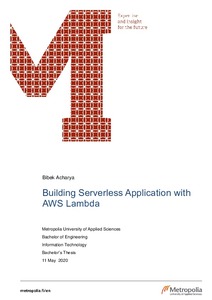Building Serverless Application with AWS Lambda
Acharya, Bibek (2020)
Acharya, Bibek
2020
All rights reserved. This publication is copyrighted. You may download, display and print it for Your own personal use. Commercial use is prohibited.
Julkaisun pysyvä osoite on
https://urn.fi/URN:NBN:fi:amk-2020052714374
https://urn.fi/URN:NBN:fi:amk-2020052714374
Tiivistelmä
The purpose of this thesis is to analyze the development of serverless application using AWS Lambda. Another aim was to study serverless architecture with AWS Lambda to build and manage secure serverless applications on AWS. Establishing the evolution of serverless computing along with several cloud vendor's functions can be discovered in this writing. Moreover, the theoretical part presents serverless technology with its history, use cases, pros, cons, and ultimately the features.
The base foundation of the writing is the Lambda function managed by AWS. Employing Lambda as serverless logic, faster, event-driven, cost-effective, secure applications can be built by meeting every compliance concern at every slab. Slightly, touching down the Function as a Service with its vendors, this study clearly shows how AWS has been a success ever since it was launched.
As a result of this study, a fully serverless, scalable application was designed and implemented on the serverless database with a new-made API. An effort was made to demonstrate how writing functions, looking at DynamoDB streams, events subsystems, API, and the storage pattern should be carried out. Finally, this study shows the benefits of next-generation serverless architecture without bothering to scale applications or manage servers.
The base foundation of the writing is the Lambda function managed by AWS. Employing Lambda as serverless logic, faster, event-driven, cost-effective, secure applications can be built by meeting every compliance concern at every slab. Slightly, touching down the Function as a Service with its vendors, this study clearly shows how AWS has been a success ever since it was launched.
As a result of this study, a fully serverless, scalable application was designed and implemented on the serverless database with a new-made API. An effort was made to demonstrate how writing functions, looking at DynamoDB streams, events subsystems, API, and the storage pattern should be carried out. Finally, this study shows the benefits of next-generation serverless architecture without bothering to scale applications or manage servers.
